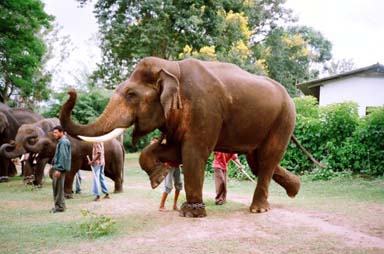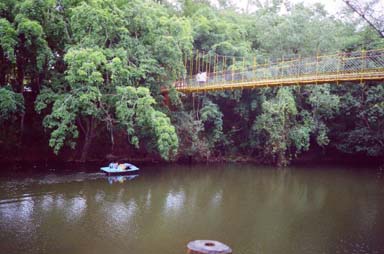Inside the woodlands of Wodeyars
Part V
-Saraswati Kavula
On our way back to Mysore we stopped at Kushalnagar to visit the Dubbare
Elephant Camp and Nisargadhama. The highlight of Dubbare was a chance to take
part in washing the elephants. Dubbare is 15 kilometers from Kushalnagar on the
banks of Cauvery. The place was almost picturesque except for the mad blaring of
a song from the film happening nearby. One has to cross the Cauvery in a motor
launch in order to reach the campsite. There are 14 elephants in all. The fees
is 20 rupees, for the river crossing and another 75 for the interaction with
the elephants which includes bathing the elephants, drill, feeding and briefing
about the camp. Those come to just take a peek can do so, paying just 20 rupees.
As people started to come in the little booking office also doubled up as a
sales counter, selling souvenirs. The wash was enjoyed by the kids and the
animals alike. But the drill turned out to be a demonstration of circus feats by
the elephants after reasonable raps on the
forehead with a sharp edged stick by their “trainers”. Quite a few elephants
had chains on their feet. “Look at the feet, the skin looks so bruised, they
must be in so much pain” rued my niece. For the people who came there, this was
another entertainment. After having sufficiently performed for the crowd,
enabling us to take some good photographs, the big fellows were taken for the
feeding ritual. Imagine being crowded around by nearly 50 people staring at you,
as you wish to eat your first meal in the day!

When I mentioned this to Muruli from the Coorg Wild Life Society, who runs the
boat service at Dubare, he said, “This used to be the elephant training camp of
the Mysore Kings. Later it was taken up by the Forest department. Now, they
opened this to public for tourism purpose. We have been telling them this is not
a good thing for conservation; the elephants must live in the wild, not like
this. But they don’t bother. They want the tourists. And the tourists want some
entertainment!” I told him about the denuded hills around Bandipur Safari
Lodge, and the claim that it was a semi-deciduous forest. “How the topography
change within a short span of few kilometers?” “No, most of this area is
tropical forest, a lot of it is gone, what you saw in the Safari area of
Bandipur is actually replanted forest by the forest department. Here in Dubare
also, out of the 13,000 hectares of forest area, nearly 8000 hectares is teak
plantation, planted by the forest department, after they
cut down the natural forest. But still the remaining area is natural forest and
we are fighting to let it survive”, replied Muruli. “But in Bhagamandala, we saw
a lot of natural forest”, I continued my query. “Well, thankfully, teak doesn’t
grow in the cooler climates, otherwise our forest department would have cut that
forest down to make way for teak plantations!”
Some people stayed back for a picnic on the rocks in the middle of the river.
And bits of discarded paper plates, plastic carry bags and soft drink bottles
were floating around them.
The next stop was Nisargadhama, a little island on the Cauvery, with some
bamboo plantations grown by the forest department. A hanging bridge takes you to
the other side of the island, which has some bamboo cottages overlooking the
river, a small restaurant, some swings and tree houses and a deer park. One can
go for an elephant ride, pedal a boat in the river or just look at the miserable
deer behind the iron mesh boundary, fed on dry worn out grass. The elephant ride
was nice except for the occasional rap with shrapnel on the elephant’s forehead
given out by the mahout to prevent the animal from eating the bamboo shoots
hanging from the top. “Why do they hit so badly? And that too on its forehead,
where it hurts the most?” my niece asked. That reminded us of the incident of
our first elephant ride at Bandipur. There the animal was hit with a bamboo
cane, to sort of get it into action. As we finished our turn and were getting
down, a banana seller asked the tourists to
buy bananas to offer to the elephant. That seemed like a good idea, which
turned sour, as one lady was just busy posing with the bananas next to the
elephant, in front of a camera. The animal was waiting and wanting to eat the
fruit. Meanwhile, the next batch of riders had climbed up and wanted to leave.
The Mahout hit the animal asking it to move. Our lady tourist was still busy
with her poses, not getting the right picture, and the animal did not wish to
leave without eating the fruit. Our Mahout was getting worked up, for lost time,
means lost revenue, so he really hit the animal so hard, that it screamed out
loud in pain and of course had to move without eating the bananas.
The second elephant ride which concluded with the shrapnel hitting the
elephant gave us a new resolve. “I will never ever ride an elephant in my life,”
my niece and nephew, said in unison. The restaurant, run by the forest
department, served tea in disposable plastic, and lot of packed foodstuffs. And
the surrounding area was filled with lots of plastic bottles, wrappers,
disposable cups etc, etc. As we left the place, I saw a board at the entrance
which read, “No plastic Zone”.
On returning to Mysore, we went to see the migratory birds at Ranganatittu
bird sanctuary, certainly a much better maintained place compared to
Nisargadhama. One did not find any plastic lying around only a few used condom
packets under a bamboo bush. The sight of the birds all over the little islands
inside the river was really refreshing. I began to wonder at how little these
creatures ask for, even a little bit of green and some sort of a watering hole,
they survive some how. And how much we ask for, without giving back much to
nature? Do we have this right to bulldoze all the other inhabitants of the
earth?

I suppose I am living in a fools’ paradise thinking these thoughts. As we went
past the once garden city of Bangalore, I realized that people thought
otherwise. Bangalore has a severe water problem, the city is terribly hot, the
roads are clogged with vehicles and of course no body can breathe normal. (Not
too different from Hyderabad). Yet one finds every day a new lake replaced by a
concrete structure and new forests cut down to make way for glasshouses. At one
time, Banarghatta National Park was some 20 kilometers from Bangalore city.
Today, the city barely leaves the boundary of the National Park in tact. The
sight at the Park itself was a revelation. A huge hotel was under construction
very close by, in addition to the existing little eating places, shops selling
various things like, packed foods, mineral water, camera rolls, knickknacks etc
etc, in front of the Park gates. Not to forget the huge parking area being built
to accommodate the great number of vehicles.
We were lucky to have arrived a little early for the Grand Safari. An hour
later we would have been squashed in the crowds. The buses taking the tourists
on Safari roared around, while we waited in the queue for our turn. “Anybody,
just two or three people?” the man at the entrance asked us, and finally the
three of us, who were the last to climb in, squashed into the last seat. We did
see a lot of tigers, lions and bears, an elephant, some deer, bison; but when
one compares with the area of the Park, there were a lot many carnivores, than
the area would naturally support. I suppose, they must be fed by the Park
keepers in order to sustain them. Sure enough, the animals had to get back into
their cages after vehicle after vehicle of screaming tourists, had their fill of
seeing the animals. “I think the animals are looking better in the Bandipur
forest than here”, said my nephew. “I suppose, they are happier when they are
free”. “Actually, when they are able to hunt, they
are healthier, rather than when they are fed by us. I read it somewhere”, my
neice replied. “I guess it applies to us too. As we begin to make life more
“comfortable”, we begin to get sluggish”, I replied.
The zoo was something; smelly, small cages, in the hot stuffy climate. What
cruelty one can imagine. The worst hit seemed to be the Himalayan Bear, (which
lives in the cold climes of the Himalayas), now suffering inside a cage in
boiling hot Banergatta!
Anyway, after our fill of bhelpuri and ice-cream, we too left the park,
feeling no better than the other tourists. Outside there was the usual scene –
an elephant ride, hankering tourists, frustrated mahout, in addition to the long
queues of vehicles, buses, people, shops, cat calls, nimbu pani, ganna ras,
mineral water…reminded me of the exhibition grounds of Hyderabad, where the
annual Numaish, was meant for people to sell their wares – crafts, food,
electronic gadgets, camel rides….
For now, Bandipur is an island of peace and quiet. Only time will tell, if the
Mysore- Ooty road will begin to resemble the environs of Banerghatta in future.
-Concluded